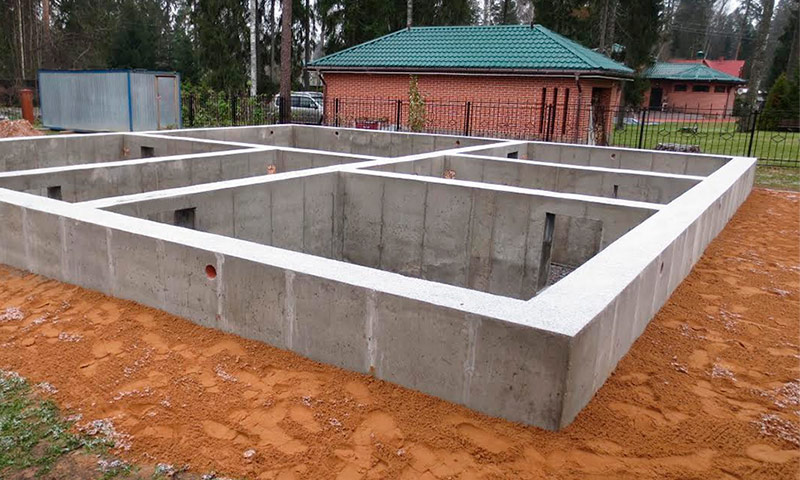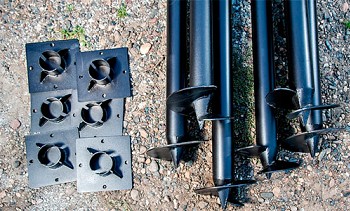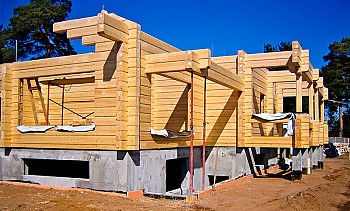The construction of any residential building, industrial building, other type of building begins with the preparation of the foundation. Correct calculation and installation of the base is a guarantee of long-term operation of the building without settlement, the appearance of cracks in the walls, the occurrence of other problems with violation of the geometry.
In modern construction, various types and types of foundations are used, the choice of which depends on: the characteristics of the soil on which the house is built; the size of the building; used wall and structural materials; climatic conditions; groundwater level.
These and other factors determine the choice of design option that is optimal for a particular house. The foundation must not only support the weight of the building, but also have a sufficient margin of safety to compensate for unforeseen loads, natural disasters (for example, floods, severe frosts causing swelling of the soil, etc.) and increase the weight of the building due to additional external and internal decoration, redevelopment, increase in number of storeys, snow on the roof.
In residential and industrial construction, various foundations are used, differing in the complexity of installation, bearing capacity, cost. The types of foundations for a private house are limited to several options: tape; plate; pile.

Strip foundations
This type of foundation is most common in private construction. Although the strip foundation requires a certain amount of excavation and significant consumption of concrete, it is the most reliable solution for stone, brick, block, expanded clay and slag concrete houses. It maintains a significant weight of the walls, evenly distributing it around the entire perimeter and exerts uniform, but not excessive, pressure on the ground, due to the large area of the support.
Structurally, the strip foundation is a monolithic reinforced concrete structure running along the entire perimeter of the house and under all load-bearing walls. Often, a concrete base is poured under the partitions - this somewhat increases the cost of the structure, but significantly increases its reliability. Strip foundations allow you to equip basements, ground floors, garages under the house - in this case, the foundation is deepened to the height of the underground room and its bearing capacity does not decrease at all.
There are various types of strip foundations, which according to the installation method can be divided into two large groups - monolithic and prefabricated.
Monolithic strip foundation
For monolithic installation, you will need:
- sand;
- gravel or rubble;
- cement;
- fittings;
- boards or special panels for formwork.
The installation technology is quite simple - a trench is excavated around the entire contour of the house (including internal walls and lintels) with a width of 0.4 - 0.8 m, depending on the thickness of future walls. The width of the trench should be 10 - 15 cm wider than the calculated dimensions of the foundation. The expansion of the trench is necessary to enable the installation of formwork. After mounting the formwork, a reinforcing belt of reinforcement with a diameter of 10 - 18 mm is connected inside. During the construction of a two-story house, reinforcing piping is installed both in the underground and in the aerial parts of the foundation.
Concrete mixed directly at the site or ready (from the factory) is poured into the formwork one day before the full height of the foundation. This achieves the necessary strength and water resistance of the base. Many private developers make a very dangerous mistake - in one working day they pour concrete into the trench, and in the second - into the upper part of the formwork.The seam that appeared at the point of contact greatly reduces the strength of the foundation and serves as a hotbed of water erosion.
Monolithic strip foundations are convenient in that they can have a fairly complex configuration, including curved contours. It is important only to correctly set the formwork and establish a reliable arm belt.

Prefabricated strip foundation
Prefabricated foundations are mounted from prefabricated blocks of factory production. They are installed in the finished trench, connected by steel wire, and the seams are filled with cement mortar. To install such a foundation, lifting equipment of medium power is required. Prefabricated strip foundations are very strong and durable - the service life exceeds 150 years.
But in the use of blocks there is one limitation - of them it is convenient to mount the foundations of only a rectangular configuration, in size multiple to the length of the block. Cutting a block is a complicated and expensive operation. Prefabricated foundations are also limited in depth. Building basements and basements from blocks is impractical - sooner or later, water will leak through the seams.

According to the depth of the laying, the tape bases are subdivided into shallow and fully buried.
Shallow strip foundation
A shallow foundation is preferred for single-story brick and wooden houses on all types of soils. It is especially appropriate for high occurrence of groundwater. It is a concrete strip on a sand cushion. Depth in the ground does not exceed 50 cm (up to 70 on soft soils).
Practice shows that with a properly prepared sand cushion at least 15 cm high and installed in accordance with all the rules of an armored belt, such a foundation does its job well. To increase the reliability of the foundation, it is necessary to install a warmed blind area with a width of at least 50 cm, which serves to drain rainwater and protect the soil around the perimeter of the house from freezing.


+ The advantages of shallow strip foundations
- Material savings compared to a fully buried strip foundation.
- Possible construction in areas with a high level of groundwater.

- Cons of shallow strip foundations
- Low rigidity.
- Very high quality reinforcement is required.
- There is a high probability of cracks in the walls built of heavy materials.
- Drainage and a sand cushion are required.
Fully buried strip foundation
Full-depth strip foundation is used in the construction of houses in two or more floors, with massive walls and concrete floors. The depth of its installation is 20 - 30 cm below the depth of soil freezing in the climatic zone of construction. This is an extremely strong and reliable design, practically unaffected by thermal deformations and not afraid of rising groundwater.
The reliability of the foundation increases the reinforcement, which is performed by knitting the frame from corrugated reinforcement. Sometimes buried strip foundations are built without reinforcement, but this is only relevant on dense and rocky soils. The cost of a fully-buried foundation is quite high - a large amount of concrete and a significant amount of earthwork are required. The price of reinforcement in the total cost will be no more than 5 - 8%, and reinforces the foundation reinforcement is very noticeable, completely eliminating the likelihood of cracks and chips. Saving on armopoyas is not worth it even with a limited construction budget.


+ The Benefits of Full-Depth Strip Foundations
- Very high design reliability.
- Not subject to temperature deformations.
- Suitable for the construction of houses with heavy walls.
- Allows you to equip a basement or ground floor under the house.

- Cons of full-depth strip foundations
- High material costs.
- A large amount of earthwork.
- It is difficult to build with a high level of groundwater.
Slab foundations
The foundations of the house in the form of a solid or prefabricated slab for the entire area of the building are less popular than strip foundations, but in some cases they are the only possible option. When building on unstable, sandy, clay, intumescent soils, with a high occurrence of groundwater (above 1 m), deep-freezing soils, it is best to fill in a continuous reinforced concrete slab on which buildings of any number of floors are erected.
For frame one and two-story houses, a slab foundation is almost an ideal solution. It is less complicated than tape and pile, but compared with them more expensive in terms of material consumption and the required amount of working time. Such foundations are often called floating - they are built without deepening and affect almost only the soil surface. Temperature and other movements of the soil on the stability of the foundation, and, therefore, the entire building, have practically no effect.

Plate types of foundations used in construction are divided into monolithic and prefabricated. The second option is more often used in the construction of large-sized buildings with a large base area and a complex perimeter configuration. For a residential building, it is better to stay on a monolithic foundation of cast reinforced concrete.

+ The advantages of slab foundations
- Simplicity of design and construction.
- Suitable for erection on very heaving, moving and subsiding soils.
- It does not require a lot of penetration into the ground.
- It can be used with a high level of groundwater.

- Cons of slab foundations
- High consumption of materials.
- The need for a basement
- Possibility of use only on horizontal platforms or with a slope of not more than 1 meter for the entire length or width of the house.
Column foundations
This type of foundations has spread along with the growing popularity of frame and panel cottages, as well as houses from glued and sawn timber. The costs of such a foundation are several times lower than for tape or slab. The main feature of such a foundation is the need to install a lower strapping made of timber or beams, which serves as the foundation of the house.
Poles are installed under all walls of the perimeter and internal partitions with an interval of up to 2.5 m (optimally 1.5 - 2 m). They are buried in the ground to a depth greater than the level of freezing and rise above the ground to the desired height. Such foundations are very convenient on uneven terrain sites - by varying the height of the posts it is easy to achieve a perfectly horizontal strapping position.
The dimensions of the pillars depend on the material of manufacture, they are built from:
- concrete;
- natural stone;
- brick;
- limestone.
The sizes vary in the range of 38 - 50 cm on the side, as a rule, in the cross section they represent a square, less often a rectangle.
According to the method of construction, columnar foundations are divided into monolithic and prefabricated.
Monolithic column foundation
The choice of option is determined by the properties of the soils at the site where the house is being built. With deep groundwater, the ideal choice would be a monolithic columnar foundation of reinforced concrete. As in the strip foundation, the reinforcing cage in the post is required in any climatic conditions.
Installation of the column foundation is carried out in several stages:
- preparation of the pit (well);
- formwork installation;
- assembly of reinforcing cage;
- pouring concrete.
In the interval between the column and the edge of the borehole (the distance should be at least 10 cm), fine gravel or sand is poured - this reduces the load on the foundation from the ground during freezing or other movements. But on soils with a risk of horizontal movements (quicksand and other unstable soils), it is not recommended to install columnar foundations - they have a low resistance to overturning and there is always a risk of disturbing the stability of the house.

Prefabricated column foundation
Prefabricated column foundations are pillars and concrete platforms made at the factory.

They are assembled in the form of a designer on the site and are interconnected by welding reinforcement and concreting joints. With all the cheapness and ease of installation, columnar foundations are quite limited in scope. They are justified on strong and stable soils for buildings no higher than 2 floors, without basements and socles. But “narrow specialization” does not reduce their attractiveness for private construction.

+ The advantages of columnar foundations
- Saving materials.
- Low labor costs.

- Cons of columnar foundations
- Weak stability in horizontally moving soils.
- The need for a basement.
- Cannot be used for buildings with heavy walls.
Pile foundations
The most popular foundations in industrial and multi-story residential construction. Often used in the construction of small private houses and cottages using modern technology. If during construction in an industrial way, houses are made of any materials on pile foundations, then in the private sector on piles there are mainly light structures from SIP panels, beams, logs.
Various types of pile foundations allow you to choose the right one for any type of structure, on virtually any soil. Piles for construction on sections of complex terrain, including on unstable soils, are very convenient. The fact is that the length of the piles is practically unlimited - they can reach a depth of 50 and more meters, which makes it possible to achieve stable soil layers on which a building of any size and weight can lean.
Modern construction technologies use three main types of piles: screw, bored and bored.
Screw pile foundation
The most popular screw piles in low-rise construction are ordinary thick-walled metal pipes with a screw in the lower part. They are screwed into the ground like ordinary screws, this is done manually or using special machines. The length of piles can reach 10 -12 m with a diameter of 50 - 150 mm.

After screwing such supports, they are cut off at a given height and connected by horizontal beams - grillage, which serves as the base of the house on which the trim is laid, the floor is laid and then the walls are erected.


+ Pluses of screw pile foundations
- Simplicity and speed of installation,
- Possibility of use on any soil
- Low cost of the finished foundation.

- Cons of foundations on screw piles
- Durability (metal in the earth is subject to corrosion).
- Need to screw deep.
- Lack of basement equipment.
Foundation on bored piles
Bored piles are mounted using another technology - first, a well is drilled in which the reinforcing cage is mounted. Then the whole structure is poured with concrete. The heads protruding above the ground are cut off at a given height and connected by a grillage. The depth of such piles can reach 50 meters.


+ Pluses of foundations on bored piles
- The possibility of building multi-story buildings on any type of soil - piles are immersed to the required depth, to dense layers that can withstand the weight of the building.
- Uniform distribution of load on the base.
- Adjustment of the weight acting on a single pile by changing the number of supports.
- Decrease in volume of earthwork.

- Cons of foundations on bored piles
- The complexity of the calculations and installation.
- The need for expensive geological surveys.
- The need to use heavy lifting and drilling equipment.
Foundation on driven piles
Hammered piles - concrete products in the form of beams of square or round cross section of large length - 12 and more meters. They are clogged into the ground by shock devices or by vibration dipping. They are used mainly in industrial construction - complex and expensive equipment is required for driving.

Having considered all the main types of foundation for a private house, the choice of the best option is simplified. For brick, block and stone buildings, the optimal foundation is strip. For frame construction, houses made of timber and logs, slab or pile (screw) are more suitable, on strong soils - columnar. But in each individual case, its own option is chosen, the main thing is that the foundation fulfill its main function - it serves as a reliable support for the home.


